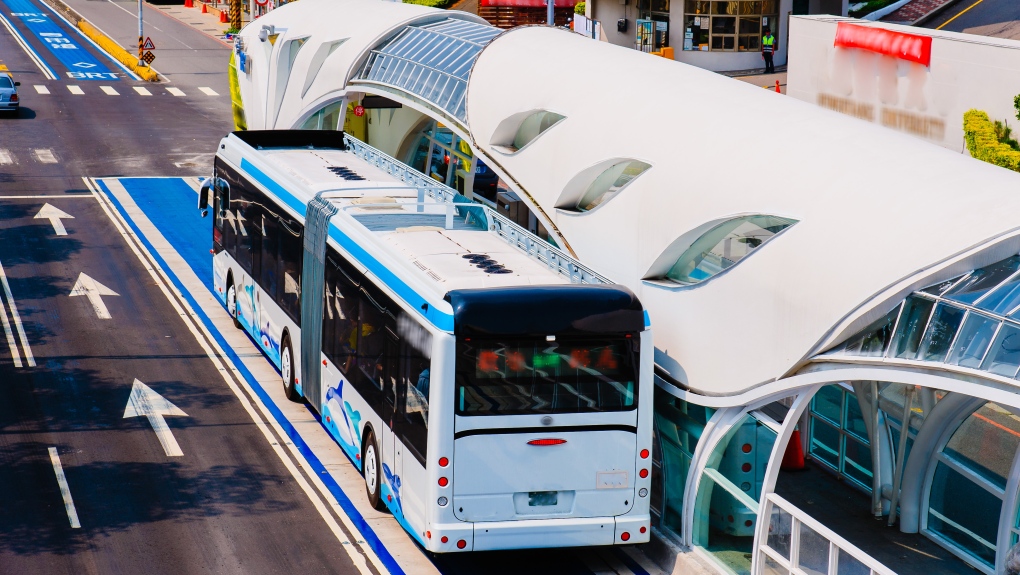TransLink adopts 10-year priorities, emphasizes Bus Rapid Transit
 An example of Bus Rapid Transit in Taiwan is seen in this image provided by TransLink.
An example of Bus Rapid Transit in Taiwan is seen in this image provided by TransLink.
Metro Vancouver's regional transit provider adopted its priorities for the next 10 years last week. While some well-known projects like the SkyTrain to UBC and the SFU gondola were near the top of the list, much of the planning document is dedicated to smaller, cheaper improvements to the system.
TransLink's Transport 2050: 10-year Priorities document promises what the transit agency calls in a news release "an unprecedented increase in local bus service," with new or enhanced local service in nearly two dozen neighbourhoods, plus 11 new RapidBus lines and seven new express buses.
In all, TransLink estimates that its priorities represent a 130-per-cent increase in bus service across Metro Vancouver.
Part of that increase is intended to lay the groundwork for the introduction of Bus Rapid Transit (BRT). TransLink says "up to nine" BRT lines could be developed in the next decade, though the actual total and timeline will depend on the support of local governments.
A BRT line is, essentially, a bus that operates as if it were a SkyTrain. BRT buses run on existing roadways, but in dedicated lanes separated from regular traffic. They serve stations, rather than roadside stops, with real-time schedule information and in-station fare payment.
BRT lines also have signal priority at intersections, minimizing the amount of time passengers spend stopped at red lights.
The planning document identifies nine "BRT candidate corridors" and calls for TransLink to "identify conceptual requirements, such as alignments, right-of-way and lane reallocation needs" for each of them.
The first actual implementation of BRT in the region would not occur until TransLink's 2025 investment plan, when two to four lines would be prioritized "based on which candidate corridors have strong local government support and high likelihood of successful implementation."
The transit agency notes that support from municipalities for conceptual requirements, "particularly road space allocation," will be a key consideration in the planning process.
The nine candidate corridors are as follows:
- Hastings Street, replacing the current R5 RapidBus
- King George Boulevard from Surrey to White Rock
- Haney Place in Langley, serving 200 Street, Golden Ears and Lougheed Highway
- Lougheed Highway, replacing the current R3 RapidBus
- Lynn Valley, Lonsdale and Downtown Vancouver via the Lions Gate Bridge
- Marine Drive Station to 22nd Street Station via Marine Way
- Metrotown to Park Royal via Second Narrows
- Richmond Centre to Metrotown via the Knight Street Bridge
- Scott Road in Surrey, replacing the planned R6 RapidBus
"The heavy emphasis on BRT in these 10-Year Priorities is for good reason," reads the planning document.
"While BRT does require reallocation of traffic lanes to dedicated rapid transit running ways, its lower cost means that we can bring fast, frequent, and reliable rapid transit service more quickly and affordably and to more areas of the region than would otherwise be possible with a rail-only approach. In this way our region can realize an almost doubling of the rapid transit network in 10 short years."
TransLink's plans call for BRT buses to be zero-emission vehicles with "spacious" interiors.
CTVNews.ca Top Stories

Prime Minister Trudeau meets Donald Trump at Mar-a-Lago
Prime Minister Justin Trudeau landed in West Palm Beach, Fla., on Friday evening to meet with U.S.-president elect Donald Trump at Mar-a-Lago, sources confirm to CTV News.
'Mayday! Mayday! Mayday!': Details emerge in Boeing 737 incident at Montreal airport
New details suggest that there were communication issues between the pilots of a charter flight and the control tower at Montreal's Mirabel airport when a Boeing 737 made an emergency landing on Wednesday.
Hit man offered $100,000 to kill Montreal crime reporter covering his trial
Political leaders and press freedom groups on Friday were left shell-shocked after Montreal news outlet La Presse revealed that a hit man had offered $100,000 to have one of its crime reporters assassinated.
Questrade lays off undisclosed number of employees
Questrade Financial Group Inc. says it has laid off an undisclosed number of employees to better fit its business strategy.
Cucumbers sold in Ontario, other provinces recalled over possible salmonella contamination
A U.S. company is recalling cucumbers sold in Ontario and other Canadian provinces due to possible salmonella contamination.
Billboard apologizes to Taylor Swift for video snafu
Billboard put together a video of some of Swift's achievements and used a clip from Kanye West's music video for the song 'Famous.'
Musk joins Trump and family for Thanksgiving at Mar-a-Lago
Elon Musk had a seat at the family table for Thanksgiving dinner at Mar-a-Lago, joining President-elect Donald Trump, Melania Trump and their 18-year-old son.
John Herdman resigns as head coach of Toronto FC
John Herdman, embroiled in the drone-spying scandal that has dogged Canada Soccer, has resigned as coach of Toronto FC.
Weekend weather: Parts of Canada could see up to 50 centimetres of snow, wind chills of -40
Winter is less than a month away, but parts of Canada are already projected to see winter-like weather.

































